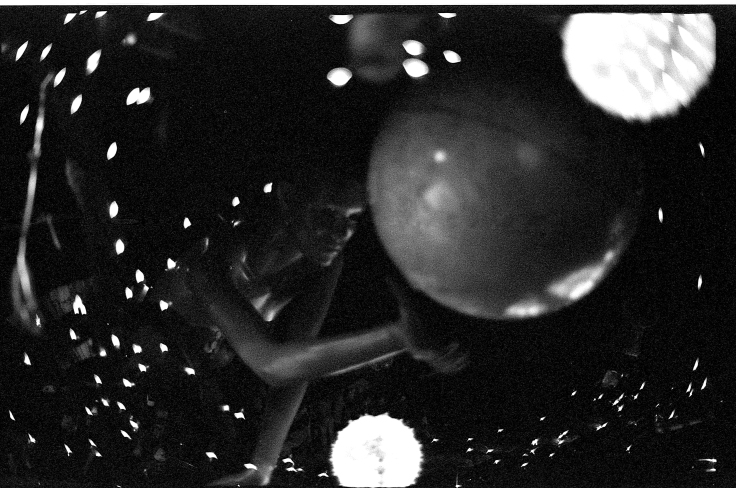I guess that I don’t typically shoot my Leitz 50’s in wooded areas. But slowly, an image here, and image there, I began to notice something.
When I shot portraits at closer distances and wider apertures in wooded areas with my Leitz Summitar and Summarit lenses, I got something unexpected. Something that I’d always associated with Russian lenses; swirlios.


Swirlios, swirly bokeh or as it’s properly termed, Petzval field curvature occurs when a lens cannot focus evenly outside its depth of field. Due to the convex shape of a spherical optical element, the area towards the edge of the glass is further out of focus than the area towards the center of the glass, thus the lens sort of makes an imprint of its shape on the out of focus background of the photograph.
Modern lenses correct for this but many vintage lens designers sacrificed an even out of focus background for a speedier optic. The first lens to display this characteristic, and for whom its named, is the Joseph Petzval designed 160mm f3.5 which was first built by Voigtlander in 1840. At the time, this was a blazingly fast maximum aperture and enabled shooters to take portraits in natural environments for the first time. And so, it seems for decades to come, when lensmakers were building their first fast lenses, a little bit of Petzval field curvature tended to creep in.

My two swirlios lenses, the Leitz 5cm f2 Summitar which was released in 1939, and Leitz 5cm 1.5 Summarit of 1949, were among Leica’s earliest fast normal lenses. The famed Leitz 50mm f2 Summicron would replace the Summitar and eliminate swirlios, as would the Leitz 50mm 1.4 Summilux in the case the case of the Summarit.
But I wasn’t aware of any of this until I did some research. Conventional internet wisdom associates swirlios with Russian glass like the Zenit Helios 50, 58 and 85mm lenses. I imagine that the nickname “swirlios” is actually derived from “Helios.” The Russian manufacturer, Lomo even re-released an all brass, simple aperture Petzval lens in modern SLR mounts a few years back. Maybe the Russians just love the swirl more than the Germans who apparently invented it?

The other thing I wasn’t aware of is that this swirlios effect only occurs when vegetation such as trees, leaves, or grass is the background and you’re focused to something within 3 to about 6 feet or so from the lens with the aperture stopped down no more than a low middle aperture like f4. Get the conditions only slightly wrong, stop down too much, get too close to your background or too far from your subject and the out of focus area will be rendered like any other lens.
By the way, there’s nothing special about vegetation from an optical stand point! If your background is anything with lots of little details in woven type pattern, the effect should occur, but most commonly, this will happen with vegetation or say, numerous light bulbs.

And I guess that it’s due to the specificity of requirements to make these lenses exhibit swirlios that they aren’t reknowned for it. In fact, I bet there are many early lenses that can do this but people just aren’t shooting them this way. Which is a shame, because I happen to quite like it!
Sure it’s distracting and by all strict definitions is “bad bokeh,” but it’s another arrow in the quiver, right? For when the moment needs a little boost of magic!

What are your thoughts on swirlios? Love it, hate it? Don’t care? What lenses have you used that exhibit it? Let me know! And thanks for reading!
Follow, Favorite, Like, Add, Contact Johnny Martyr









I think the swirl is a cool effect 😎
LikeLiked by 1 person
Natalie, do any Hasselblad lenses swirl?
LikeLiked by 1 person
I only currently have the 80mm Lens but as far as I’m aware, I’ve not seen any swirl effects on it yet….
LikeLiked by 1 person
Some of my japanese lenses do a similar thing, one of the sides gets swirly at wide apertures, revuenon 1.7 and the zuiko 50 1.8 as well, but not just in the out of focus areas but everywhere.
LikeLiked by 1 person
Hmmm, well the out of focus swirl is caused by specific properties of the lens. Any swirl you might see on in focus areas must be caused by something different based on my research and understanding of Petzval field curvature. I have used the Zuiko 50/1.8 pretty extensively and haven’t seen this. Would love to see your examples though, maybe we can get to the bottom of this!
LikeLike
actually now that I’m looking at the photos, the swirly areas are out of focus, I don’t know how to add them to this reply, so I uploaded both to flickr: Zuiko 50 1.8 (https://www.flickr.com/photos/22366347@N02/48704731847/in/dateposted-public/) and Revuenon (https://www.flickr.com/photos/22366347@N02/48704568056/in/dateposted-public/)
LikeLike
I have the Helios 58mm f/2 and love the effect. So much so that I would not be upset if I could get it in all of my shots.
LikeLiked by 1 person
The Helios is a classic for swirl! Do you find it difficult to make the swirl happen? It took a few years of use (without searching for it) of my Leitz lenses to figure out how to make the swirly background.
LikeLiked by 1 person
Actually, yes. But I intend on using your advice from the article. In fact, I did just that today with a shot of my son. I didn’t get the swirl I wanted but it wasn’t exactly the optimum background to use.
LikeLiked by 1 person
I hope my tips work out better next time! I’d love to see what you come up with.
LikeLiked by 1 person
Yeah, there was nothing wrong with the tip, the problem was in the background. I will certainly be working more and more with this kind so I’m sure you will see something pop up from time to time. 😁
LikeLiked by 1 person